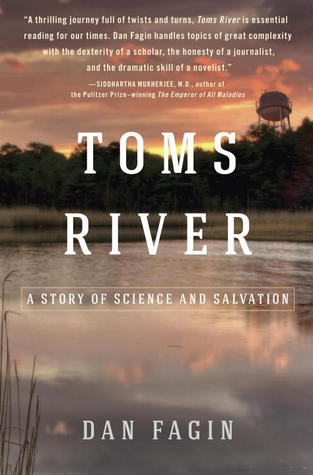J.S.'s Reviews > Toms River: A Story of Science and Salvation
Toms River: A Story of Science and Salvation
by

by

The problem for manufacturing companies, and especially chemical manufacturers, is what to do with the waste products. Disposing of it safely can get expensive and eat into profits, so historically companies just dumped it in a river and it was on its way to the ocean - or at least it wasn't their problem anymore. Of course, a river can only take so much before people start to notice... and complain!
Toms River was a pretty little place near the Jersey shore when Ciba-Geigy relocated their manufacturing there in 1949. They were moving operations from Cincinnati (and the Ohio River) where they'd been making fabric dyes from petroleum and tar products for years. Before that they'd made their products in Basel, Switzerland, along the banks of the Rhine River. They purchased a large piece of wooded New Jersey property and built their factory in the middle, surrounded by trees that hid it from the outside. But they didn't dump *all* their wastes into the river - that would have drawn complaints. Instead they burned some of it (at night to reduce complaints from the town) and built holding ponds on the property. Unfortunately those ponds weren't lined and the wastes seeped easily into the sandy soil (the level sometimes dropping as much as five feet in a day) and into the groundwater that provided the growing town's drinking water. But it wasn't just Ciba polluting the town and water. In an effort to keep disposal costs down, Union Carbide paid a contractor to "dispose" of their wastes and it and it ended up being dumped in a pit in a back corner of an old egg farm.
Dan Fagin tells the story of how a cluster of children in Toms River (actually named Dover Township) developed cancer and the medical sleuthing that was able to point the finger at the toxic wastes being generated nearby. And for a fairly lengthy book (460 pages) it's hard to put down. Fagin covers not only Toms River but also the history of how links to cancer were uncovered along the way - and it's a fascinating story. I found his explanations of how cancers happen (there are about 150 different kinds) as well as the history of the chemical industry very interesting, not to mention disturbing - the part about "salvation" in the title is misleading, since there wasn't much of it in the story. The science gets a little technical, but not overly so. And it's plain from the beginning who the bad guys in this story are, but Fagin does a good job explaining why it's so difficult to *prove* blame in such cases even if his telling doesn't always feel very balanced. And as for blame, Fagin makes it pretty clear it wasn't just the chemical companies - plenty of people from politicians to plant workers were perfectly willing to turn a blind eye to what was going on.
Toms River was a pretty little place near the Jersey shore when Ciba-Geigy relocated their manufacturing there in 1949. They were moving operations from Cincinnati (and the Ohio River) where they'd been making fabric dyes from petroleum and tar products for years. Before that they'd made their products in Basel, Switzerland, along the banks of the Rhine River. They purchased a large piece of wooded New Jersey property and built their factory in the middle, surrounded by trees that hid it from the outside. But they didn't dump *all* their wastes into the river - that would have drawn complaints. Instead they burned some of it (at night to reduce complaints from the town) and built holding ponds on the property. Unfortunately those ponds weren't lined and the wastes seeped easily into the sandy soil (the level sometimes dropping as much as five feet in a day) and into the groundwater that provided the growing town's drinking water. But it wasn't just Ciba polluting the town and water. In an effort to keep disposal costs down, Union Carbide paid a contractor to "dispose" of their wastes and it and it ended up being dumped in a pit in a back corner of an old egg farm.
Dan Fagin tells the story of how a cluster of children in Toms River (actually named Dover Township) developed cancer and the medical sleuthing that was able to point the finger at the toxic wastes being generated nearby. And for a fairly lengthy book (460 pages) it's hard to put down. Fagin covers not only Toms River but also the history of how links to cancer were uncovered along the way - and it's a fascinating story. I found his explanations of how cancers happen (there are about 150 different kinds) as well as the history of the chemical industry very interesting, not to mention disturbing - the part about "salvation" in the title is misleading, since there wasn't much of it in the story. The science gets a little technical, but not overly so. And it's plain from the beginning who the bad guys in this story are, but Fagin does a good job explaining why it's so difficult to *prove* blame in such cases even if his telling doesn't always feel very balanced. And as for blame, Fagin makes it pretty clear it wasn't just the chemical companies - plenty of people from politicians to plant workers were perfectly willing to turn a blind eye to what was going on.
Sign into Goodreads to see if any of your friends have read
Toms River.
Sign In »
Reading Progress
May 2, 2013
–
Started Reading
May 2, 2013
– Shelved
May 5, 2013
–
Finished Reading


